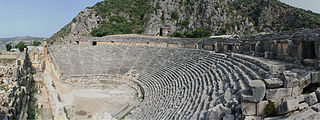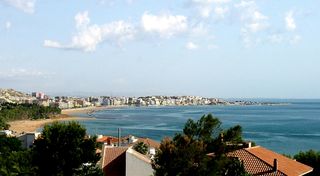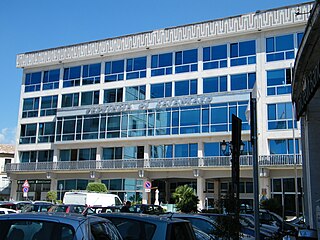Related Research Articles

Magna Graecia was the name given by the Romans to the coastal areas of Southern Italy in the present-day Italian regions of Calabria, Apulia, Basilicata, Campania and Sicily; these regions were extensively populated by Greek settlers. These settlers, who began arriving in the 8th century BC, brought with them their Hellenic civilization, which left a lasting imprint on Italy. They also influenced the native peoples, such as the Sicels and the Oenotrians, who became hellenized after they adopted the Greek culture as their own. The Greek colonists of Magna Graecia elaborated a civilization of the highest level, which had peculiar characteristics, due to the distance from the motherland and the influence of the indigenous peoples of southern Italy. The type of government was in the form of city-states (poleis) administered by the aristocracy. The Second Punic War put the end to the independence of the cities of Magna Graecia, which were annexed to the Roman Republic in 205 BC.

Myra was a Lycian, then ancient Greek, then Greco-Roman, then Byzantine Greek, then Ottoman town in Lycia, which became the small Turkish town of Kale, renamed Demre in 2005, in the present-day Antalya Province of Turkey. In 1923, its Greek inhabitants had been required to leave by the population exchange between Greece and Turkey, at which time its church was finally abandoned. It was founded on the river Myros, in the fertile alluvial plain between Alaca Dağ, the Massikytos range and the Aegean Sea.

Saint Nicholas of Myra, also known as Nicholas of Bari, was an early Christian bishop of Greek descent from the maritime city of Myra in Asia Minor during the time of the Roman Empire. Because of the many miracles attributed to his intercession, he is also known as Nicholas the Wonderworker. Saint Nicholas is the patron saint of sailors, merchants, archers, repentant thieves, children, brewers, pawnbrokers, unmarried people, and students in various cities and countries around Europe. His reputation evolved among the pious, as was common for early Christian saints, and his legendary habit of secret gift-giving gave rise to the traditional model of Santa Claus through Sinterklaas.

Pope Nicholas I, called Nicholas the Great, was the bishop of Rome and ruler of the Papal States from 24 April 858 until his death. He is remembered as a consolidator of papal authority, exerting decisive influence on the historical development of the papacy and its position among the Christian nations of Western Europe. Nicholas I asserted that the pope should have suzerainty over all Christians, even royalty, in matters of faith and morals.

Nyíregyháza is a city with county rights in northeastern Hungary and the county capital of Szabolcs-Szatmár-Bereg. With a population of 118,001, it is the seventh-largest city in Hungary and the second largest in the Northern Great Plain region. Its development has been ongoing since the 18th century, making it the economic and cultural center of the region. Nyíregyháza Zoo, with over 500 species, is recognized throughout Europe.
Anastasius Bibliothecarius or Anastasius the Librarian was bibliothecarius and chief archivist of the Church of Rome and also briefly a claimant to the papacy.

Football Club Crotone S.r.l., commonly referred to as Crotone, is an Italian football club based in Crotone, Calabria. They play in the third division of Italian football, the Serie C. Founded on 20 September 1910, it holds its home games at Stadio Ezio Scida, which has a 16,647-seat capacity.

The province of Catanzaro is a province of the Calabria region of Italy. The city Catanzaro is both capital of the province and capital of the region of Calabria. The province contains a total of 80 municipalities (comuni). Its provincial president is Sergio Abramo.

The province of Crotone is a province in the Calabria region of southern Italy. It was formed in 1992 out of a section of the province of Catanzaro. The provincial capital is the city of Crotone. It borders the provinces of Cosenza, Catanzaro, and also the Ionian Sea. It contains the mountain Pizzuta, the National Park of the Sila, Montagnella Park, and the Giglietto Valley. Crotone was founded in 710 BCE. It participated in the Second Punic War against the Roman Republic.

Rossano is a town and frazione of Corigliano-Rossano in the province of Cosenza, Calabria, southern Italy. The city is situated on an eminence c. three kilometres (1.9 mi) from the Gulf of Taranto. The town is known for its marble and alabaster quarries.

Isola di Capo Rizzuto is a comune (municipality) in the province of Crotone, Calabria, Italy. The population of the town is around 15,000.
Santa Severina is a town and comune in the province of Crotone, in the Calabria region of southern Italy. It is a member of the I Borghi più belli d'Italia association.

Umbriatico is a comune and town in the province of Crotone, in Calabria, southern Italy. As of 2007 Umbriatico had an estimated population of 930.

Contra errores Graecorum, ad Urbanum IV Pontificem Maximum is a short treatise written in 1263 by Roman Catholic theologian Saint Thomas Aquinas as a contribution to Pope Urban's efforts at reunion with the Eastern Church. Aquinas wrote the treatise in 1263 while he was papal theologian and conventual lector in the Dominican studium at Orvieto after his first regency as professor of theology at the University of Paris which ended in 1259 and before he took up his duties in 1265 reforming the Dominican studium at Santa Sabina, the forerunner of the Pontifical University of Saint Thomas Aquinas, Angelicum, in Rome.

The Archdiocese of Crotone-Santa Severina is a Roman Catholic ecclesiastical territory in Calabria in southern Italy, created in 1986 when it was combined with the Diocese of Santa Severina. It is now a suffragan of the Archdiocese of Catanzaro-Squillace. In 2013 there was one priest for every 1,841 Catholics.
The following cathedrals, churches and chapels are dedicated to Saint Nicholas:
The archdiocese of Santa Severina was a Roman Catholic ecclesiastical territory in Calabria, southern Italy, that existed until 1986. In that year it was united into the diocese of Crotone, forming the Archdiocese of Crotone-Santa Severina.

The Italo-Albanian Catholic Church or Italo-Albanian Byzantine-Catholic Church is one of the 23 Eastern Catholic Churches which, together with the Latin Church, compose the Catholic Church. It is an autonomous (sui juris) particular church in full communion with the Pope of Rome, directly subject to the Roman Congregation for the Oriental Churches, but which follows the Byzantine Rite, the ritual and spiritual traditions that are common in most of the Eastern Orthodox Church. It uses two liturgical languages: Koine Greek, the traditional language of the Eastern Churches, and Albanian, the native language of most of its adherents.

St. Nicholas Church is an ancient East Roman basilica church in the ancient city of Myra, now a museum located in modern Demre, Antalya Province, Turkey. It was built above the burial place of St Nicholas, a 4th-century Christian bishop of Myra, an important religious figure for Eastern Orthodox Christians and Roman Catholics and the historical inspiration for Santa Claus. Its use dated from its 6th century construction for the state church of the Roman Empire by Justinian the Great. The basilica is on UNESCO's tentative list to become a World Heritage Site.
References
Norwich, John Julius (1996). Byzantium: The Decline and Fall. New York: Alfred A. Knopf.